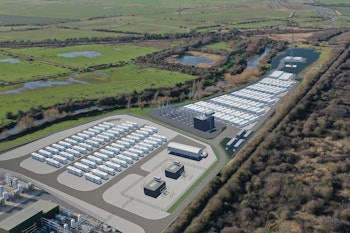The making of a world-class energy park
By Scott Poulter
A vision of energy systems to come is taking shape in Kent, on the English coast.
Richborough Energy Park, located on the former home of a thermal power station close to the mouth of the River Stour near Sandwich, is seeing the installation of battery energy storage systems that soon will be a common part of grids worldwide.
The project, the first of several planned by Pacific Green in the UK, will see 100 MW of battery capacity delivering valuable services to the UK grid from the first half of 2023. This photo essay charts the making of this ground-breaking initiative.
The start of a great undertaking
Pacific Green acquired the rights to the Richborough project from Tupa Energy, as part of an exclusive agreement to develop up to 1.1 GW of UK energy storage capacity.
In September 2021, Pacific Green went on to secure £23 million in debt finance from Close Leasing to help fund the project, and in May 2022 Green Power Reserves made an equity investment of £13 million for a 50% shareholding in the scheme.
A June 2022 deal for more than £28 million in senior debt allowed the project to reach financial close—and for development to start in earnest.
An outstanding team
To bring the project to fruition, Pacific Green has assembled one of the most experienced teams in the business, led by Christo Hammes, here pictured right with Vincent Bowler, managing director of Richborough Energy Park’s engineering, procurement and construction partner Instalcom.
Hammes and his teammates have a long history of project development in major electric power schemes for organisations such as National Grid, Siemens and Limejump.
As well as delivering engineering and construction services, in May 2022 Instalcom was awarded the operations and maintenance contract for Richborough after it is commissioned.
Technological excellence
The 2.9-metre-high, containerised battery systems being installed at Richborough use a chemistry called lithium ferro-phosphate or LFP.
While belonging to the same high-performance family as those used in electric vehicles, LFP batteries have a much lower risk of overheating, making Richborough an inherently safe installation.
Also, LFP batteries do not use cobalt, which is subject to supply constraints and human rights concerns as much of the metal comes from artisanal mining in the Democratic Republic of Congo.
The blueprint for further developments
With the development of Richborough Energy Park now well underway and commissioning scheduled for later in 2023, Pacific Green is applying the experience learned on the project to other UK battery schemes.
In December 2022, Pacific Green acquired 100% of the shares in Sheaf Energy Park from Tupa Energy. Dwarfing Richborough, Sheaf Energy Park will be a 250 MW, 375 MWh battery energy storage system located next to the current project in Kent (to the right of the picture).
Design and construction will begin in the first half of 2023, with the energy park scheduled to begin its 35-year operating life in April 2025. The 11-acre site, bordering Sandwich Bay, will house 201 containers and the project has the full approval of the Environment Agency.









